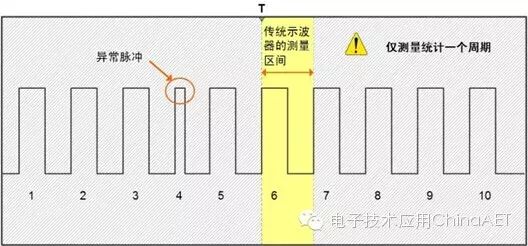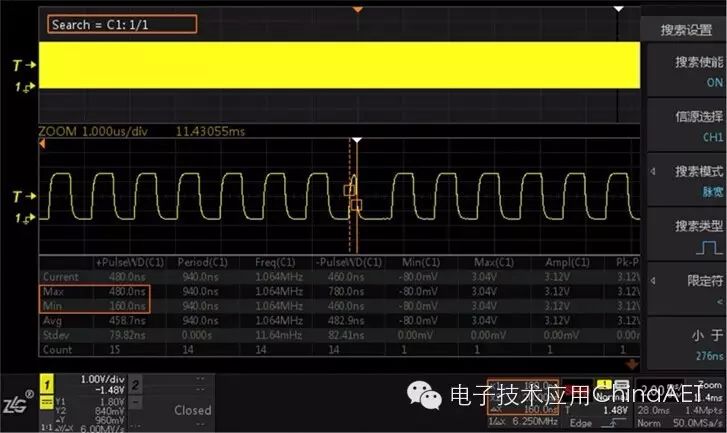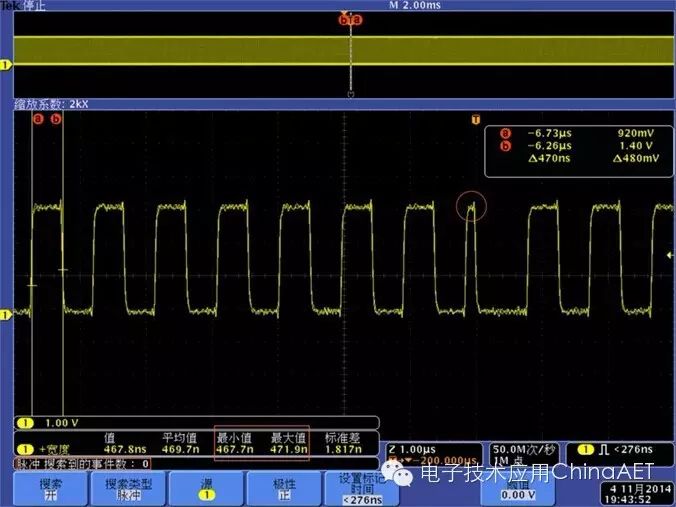Hello everyone, the oscilloscope, as a versatile measuring instrument, is fundamentally designed for measurement statistics. The oscilloscope on your lab bench may have been used many times with various functions, but have you truly paid attention to its core measurement statistics function? Is this function genuinely usable and reliable?
The ZDS2022 oscilloscope, after incorporating most functions common to oscilloscopes, has thoughtfully designed and experienced its measurement and statistics functionality. It not only includes 51 measurement parameters but can also display 24 parameter measurement results in real-time simultaneously. It uses full hardware parameter measurement, making the speed exceptionally fast. Additionally, each parameter can measure multiple data types including current value, maximum value, minimum value, average value, and standard deviation. By observing the maximum and minimum values from the statistics, you can quickly identify potential anomalies in the waveform. By analyzing the average value and standard deviation, you can swiftly assess signal characteristics. It also includes counting, allowing you to observe the sample size of the current measurement results.
In contrast, the MSO4054 oscilloscope, while standardly equipped with 30 measurement parameters, can only display a maximum of 8 parameters in real-time. Moreover, it can only select one parameter at a time, which is quite cumbersome. At this point, you might think that the measurement statistics function of the ZDS2022 oscilloscope is just about having more measurement types and faster speeds. In fact, this is just the tip of the iceberg regarding the ZDS2022 oscilloscope’s measurement and statistics capabilities.
“True Meaning” vs. “Pseudo Measurement”
The measurement statistics function of the ZDS2022 oscilloscope is a “true meaning” measurement statistics function! So, what exactly is a “true meaning” measurement statistics function?

Figure 1: Schematic Diagram of “True Meaning Measurement” Principle
The “true meaning” parameter measurement statistics utilize full storage depth for waveform measurement statistics.
Full storage depth means that if the current screen has 56Mpts of data, measurement will be conducted on all 56Mpts of data. If there are 112Mpts of data, measurement and statistics will be performed on all 112Mpts of data. The current screen data and previous screen data constitute historical data statistics, leaving no anomalies overlooked, thus accurately reconstructing the original waveform.
In contrast, the “true meaning” measurement statistics are opposed to “pseudo measurement statistics.” The term “pseudo measurement statistics” refers to measuring only one cycle from the trigger point or the leftmost cycle of the screen, regardless of how much data is present on the current screen (note that only one cycle is measured), undoubtedly missing a significant amount of valid data. The direct result of “pseudo measurement” is that the measurement statistics information it provides cannot comprehensively reflect the information of the captured data. Therefore, when you select the measurement mode of the oscilloscope as “pseudo measurement statistics,” the erroneous waveform you ultimately measure will be mistakenly considered correct, leading to incorrect conclusions.

Figure 2: Schematic Diagram of “Pseudo Measurement” Principle
Example Testing
In the measurement statistics of the ZDS2022 oscilloscope, all data displayed on the current screen participate in the measurement statistics, ensuring that any anomalies in the waveform are guaranteed to be detected. Testing with the same signal input into both the ZDS2022 oscilloscope and the MSO4054 oscilloscope, with a time base set at 2.00ms/div, results in a sampling rate of 50MSa/s for both.
The ZDS2022 oscilloscope measured the maximum value of the “positive pulse width” measurement item at 480.0ns and the minimum value at 160ns. After activating the search mode, setting the pulse width time to less than 276ns (search conditions the same as the MSO4054 oscilloscope), it accurately located the abnormal pulse. Selecting the positive pulse width measurement item allows precise measurement of the abnormal pulse width. With a single button press on [ZOOM], and using the navigation soft key, we can clearly see the searched abnormal narrow pulse in the secondary time base.

Figure 3: ZDS2022 Oscilloscope Measurement Results

Figure 4: MSO4054 Oscilloscope Measurement Results
When inputting the same signal, the MSO4054 oscilloscope failed to detect the abnormal signal, and we see that the positive pulse width measurement results do not display any abnormal pulses. Now, using the triggering function of the MSO4054 oscilloscope to trigger the abnormal pulse, the results indicate that there is indeed an anomalously narrow pulse in the signal. So, why couldn’t the MSO4054 oscilloscope search it out?
Even though we have now searched out the abnormal narrow pulse, the measurement result of the positive pulse width still does not display the presence of the abnormal narrow pulse in the signal. By moving the horizontal offset knob, when the abnormal narrow pulse moves to the left side of the screen, the maximum and minimum values of the positive pulse width measurement change to the width of the abnormal narrow pulse, demonstrating that it only measures one cycle! This is a true pseudo measurement! In contrast, the ZDS2022 oscilloscope will inevitably search out any existing anomalies in the signal, accurately locating and measuring them! The MSO4054 oscilloscope not only fails to search them out but also automatically ignores the abnormal pulse when measuring, excluding it from the measurement range! This is because the MSO4054 oscilloscope employs “pseudo measurement”!
If the oscilloscope you have at hand cannot reliably measure the waveform of the signal, then any subsequent measurement work will hold no value. If you have not yet recognized this issue, the series of measurement results you obtain will be erroneous, with potentially severe consequences! The ZDS2022 oscilloscope features “true meaning” measurement statistics that accurately reflect the characteristics of the original signal, without sampling point extraction! The ZDS2022 oscilloscope is entirely focused on your perspective, ensuring you conduct valuable measurement work. ZhiYuan Electronics is dedicated to serving every user, and your ultimate experience is our direction of progress!